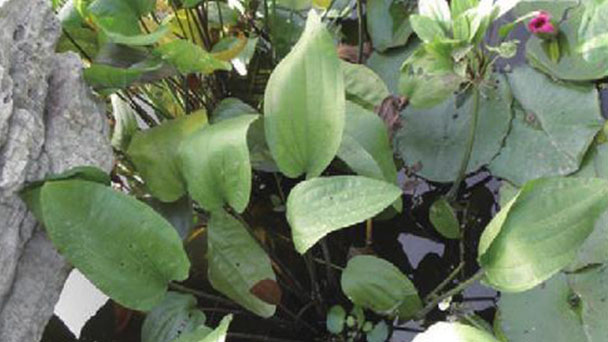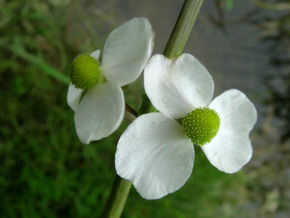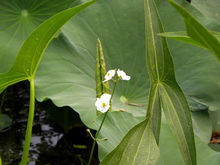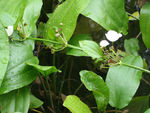Echinodorus grandiflorus profile
Written by Maggie
Mar 24 2021

Echinodorus grandiflorus is a larger swamp plant. Echinodorus grandiflorus leaf blade is heart-shaped, 40 cm long and 35 cm wide. Apex is acute, petiole spiny. Flowers are about 3.5 cm in size with 24 pistils. The fruit is 0.35 cm. The water middle lobe is oval, 15 cm long and 8 cm wide.
Echinodorus grandiflorus picture

Morphological characteristics of Echinodorus grandiflorus
Echinodorus grandiflorus leaves are dark green, heart-shaped, with thick petioles, large leaf width, 5-7 distinct veins, and straight leaves. Basal leaves, with a whisker root system, echinodorus grandiflorus height up to 50CM. The flowers are white, about 3 cm in diameter, with 3 petals, long flowering period, and can bloom from summer to autumn.
Ecological habits of Echinodorus grandiflorus
Echinodorus grandiflorus prefers a warm, well-ventilated environment and is highly adaptable. Echinodorus grandiflorus does not have strict requirements on soil, and can grow well in big and long-standing water. Sprout in spring requires a temperature of 12-14℃, growth and development of amnesia temperature 22-30℃, flowering requires a higher temperature, 25-32℃ is appropriate, after November leaves gradually withered yellow, gradually into hibernation, hibernation can be in the water, can also be on the shore, can endure the low temperature after -5℃ left. Echinodorus grandiflorus, whole all immersed in the water, either as seaweed cultivation in the aquatic animals box, also can be completely submerged in the water, the root of blade exposed to air, cultivated in plastic canopy water pool, can also be on the bank of water scene to shoot, when the water level rises, the plant will be submerged, when water levels fall completely environment that is the growth of land plants, and plant still robust growth.It has the characteristics of terrestrial and aquatic amphibians. Therefore, it can also be said that Echinodorus grandiflorus is a large perennial aquatic plant.
Distribution area of Echinodorus grandiflorus
Echinodorus grandiflorus is mainly distributed in Central America to southern Brazil.
Echinodorus grandiflorus propagation
Usually Echinodorus grandiflorus uses clonal propagation, that is, propagation by dividing the stem of the mother plant.

How to grow Echinodorus grandiflorus
Grow in an aquarium
1. Cultivation methods
Echinodorus grandiflorus can be grown in large and medium aquariums with a length of 150-100cm and a height of 50CM. The setting of the aquarium box is equipped with needed bottom sand, an oxygen bar generally, lamp, add temperature bar, fertilizer (base fertilizer and liquid fertilizer), filter etc. First of all, the need to add grass sand in the aquarium, the depth of laying grass sand is 10CM, and add basic fertilizer. An aquarium box next to other equipment is also installed one by one, and can plant all sorts of aquatic grass. A week after the Echinodorus grandiflorus are planted, some small landscape fish can be added to increase the dynamic and ornamental nature of the aquarium. Daily maintenance of aquatic plants is very important, in order to prevent the breeding of algae in the aquarium phase, algae eating fish can be put in.In the aquarium tank, Beijing should change water, add oxygen, lighting, appropriate heating, add liquid fertilizer, etc.
2. Landscape application
Echinodorus grandiflorus is a large and medium sized aquatic grass, so it can be cultivated as middle and back scene grass in aquariums. Depending on the landscape design, Echinodorus grandiflorus can be planted alone or in a cluster. With some other kinds of water plants, the whole aquarium will form a beautiful miniature landscape. But planting Echinodorus grandiflorus in the tank has the certain difficulty, because the water in the tank can't flow, the water demand of carbon dioxide, and bed sand are basic does not contain mineral nutrition for the growth of hydrophytes, weak light and water, and many other factors, if bad management, time is long can make the growth of aquatic plants gradually recession, or even close to death, greatly reduce the spectator. Therefore, it is difficult for Echinodorus grandiflorus to be managed daily, so it is necessary to create a good growth condition for Echinodorus grandiflorus to grow normally.
Echinodorus grandiflorus growing in ponds
It is difficult to cultivate aquatic grass in aquariums, so a ground aquatic grass pond is established to plant high quality aquatic grass on the ground, so as to preserve planting resources and provide high-quality aquatic grass for aquarium landscape.

Latest Updated
- Benefits of Bugleweed - 7 Science-backed Health Benefits
- Bugleweed Dangers & Side Effects - Is It Poisonous?
- How to Plant Evergreen Trees - What You Should Know
- When to Plant Evergreens - Grow Guide for Evergreen Trees
- 12 Wonderful Evergreen Shrubs for Your Garden
- 12 Popular Evergreen Plants with Pictures for Beginners
- When And How To Prune A Lilac Bush Like a Pro
- How to Grow & Care for Lilac Vine (Hardenbergia Violacea)
- Japanese Lilac Tree (Syringa Reticulata) Care & Propagation Guide
- Shumard Oak Pros and Cons - What to Know
Popular Articles
- Winter maintenance of Antirrhinum Majus
- How to Grow Terminalia Mantaly Tree
- How to Grow and Care for Crossostephium Chinense
- How to grow Antirrhinum Majus in spring
- Peristeria Elata (Dove Orchid) Profile: Info & Care Guide
- Underwatered Snake Plant (Sansevieria Trifasciata) - Signs And How To Fix
- How to Care for Brazilian Jasmine Plant (Mandevilla Sanderi)
- How to Grow & Care for Graptopetalum Purple Delight in Summer
- Rosa Chinensis (China Rose): Plant Growing & Care Tips
- How to Care for Baby Sun Rose (Aptenia Cordifolia)